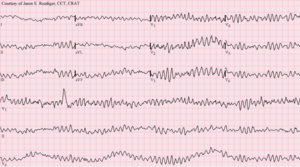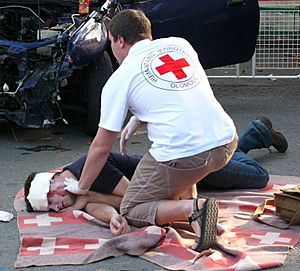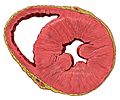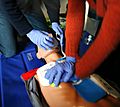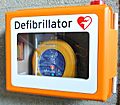Cardiac arrest facts for kids
Cardiac arrest happens when the heart suddenly stops beating. This can be caused by a heart attack in which the heart's demand for oxygen is not met and the heart muscle begins to die. With cardiac arrest, normal circulation of blood stops, because of a failure of the heart to contract. This results in the body not getting enough oxygenated blood, which causes cells to start to die from oxygen starvation. Cerebral hypoxia (lack of oxygen to the brain) makes a person lose consciousness and stop breathing, and this makes the heart stop completely. Unless the person is in hypothermia, brain damage usually occurs after three to five minutes. (In some cases, the person is put into hypothermia on purpose, to help the person recover better with less damage.)
Cardiac arrest is a medical emergency. If it is treated early enough, some of the damage done can be reversed in certain groups of patients. When cardiac arrest leads to a person's death, this is called sudden cardiac death (SCD). First aid treatment for cardiac arrest usually begins with cardiopulmonary resuscitation (CPR) to keep oxygenated blood flowing until medical treatment is available.
Contents
Risk factors
Major risk factors for cardiac arrest include age and underlying cardiovascular disease. A prior episode of sudden cardiac arrest increases the likelihood of future episodes.
Additional significant risk factors include cigarette smoking, high blood pressure, high cholesterol, history of arrhythmia, lack of physical exercise, obesity, diabetes, family history, cardiomyopathy, alcohol use, and possibly caffeine intake. Current cigarette smokers with coronary artery disease were found to have a two to threefold increase in the risk of sudden death between ages 30 and 59. Furthermore, it was found that former smokers' risk was closer to that of those who had never smoked.
Causes
Common cardiac causes include coronary artery disease, non-atherosclerotic coronary artery abnormalities, structural heart damage, and inherited arrhythmias. Common non-cardiac causes include respiratory arrest, diabetes, medications, and trauma.
Diagnosis
The physical examination to diagnose cardiac arrest focuses on the absence of a pulse. In many cases, lack of a central pulse is the gold standard. Lack of a pulse may also result from other conditions (e.g. shock) or be the rescuer's misinterpretation.
During resuscitation efforts, continuous monitoring equipment including EKG leads should be attached to the patient so that providers can analyze the electrical activity of the cardiac cycle and use this information to guide the management efforts.
Owing to the inaccuracy diagnosis solely based off central pulse detection, some bodies like the European Resuscitation Council have de-emphasized its importance. Instead, the current guidelines prompt individuals to begin CPR on any unconscious person with absent or abnormal breathing.
Images for kids
See also
 In Spanish: Paro cardiorrespiratorio para niños
In Spanish: Paro cardiorrespiratorio para niños



